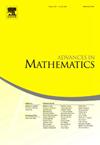Constructions of Turán systems that are tight up to a multiplicative constant
IF 1.5
1区 数学
Q1 MATHEMATICS
引用次数: 0
Abstract
For positive integers , the Turán function is the smallest size of an r-graph with n vertices such that every set of s vertices contains at least one edge. Also, define the Turán density as the limit of as . The question of estimating these parameters received a lot of attention after it was first raised by Turán in 1941. A trivial lower bound is . In the 1990s, de Caen conjectured that as and offered 500 Canadian dollars for resolving this question.
We disprove this conjecture by showing more strongly that for every integer there is (in fact, can be taken to grow as ) such that as , that is, the trivial lower bound is tight for every R up to a multiplicative constant .
求助全文
约1分钟内获得全文
求助全文
来源期刊

Advances in Mathematics
数学-数学
CiteScore
2.80
自引率
5.90%
发文量
497
审稿时长
7.5 months
期刊介绍:
Emphasizing contributions that represent significant advances in all areas of pure mathematics, Advances in Mathematics provides research mathematicians with an effective medium for communicating important recent developments in their areas of specialization to colleagues and to scientists in related disciplines.
 求助内容:
求助内容: 应助结果提醒方式:
应助结果提醒方式:


